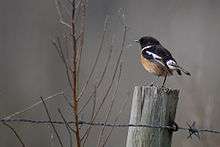Saxicola
| Saxicola | |
|---|---|
 | |
| Male European stonechat (Saxicola rubicola)
Calls made by a European stonechat, recorded on Old Dean Common, Surrey, England | |
| Scientific classification | |
| Kingdom: | Animalia |
| Phylum: | Chordata |
| Class: | Aves |
| Order: | Passeriformes |
| Family: | Muscicapidae |
| Genus: | Saxicola Bechstein, 1802 |
| Species | |
|
See text. | |
Saxicola (Latin: saxum, rock + incola, dwelling in[1]), the stonechats or chats, is a genus of 15 species of small passerine birds restricted to the Old World. They are insectivores occurring in open scrubland and grassland with scattered small shrubs.
Species
The following species are currently accepted in Saxicola:[2]
- Whinchat, Saxicola rubetra
- White-browed bush chat or Stoliczka's bushchat, Saxicola macrorhynchus
- White-throated bush chat or Hodgson's bushchat, Saxicola insignis
- Canary Islands stonechat or Fuerteventura chat, Saxicola dacotiae
- European stonechat, Saxicola rubicola
- Siberian stonechat, Saxicola maurus
- Stejneger's stonechat, Saxicola stejnegeri
- African stonechat, Saxicola torquatus
- Madagascan stonechat, Saxicola sibilla
- Reunion stonechat, Saxicola tectes
- White-tailed stonechat, Saxicola leucurus
- Pied bush chat or pied bushchat, Saxicola caprata
- Jerdon's bush chat, Saxicola jerdoni
- Grey bush chat, Saxicola ferreus
- White-bellied bush chat, Saxicola gutturalis
Species status possible,[3] but not yet verified:
- Ethiopian stonechat, Saxicola (torquatus) albofasciatus
Formerly included in Saxicola, but now treated in a separate genus:[2][4]
- Buff-streaked chat, Campicoloides bifasciatus (syn. Oenanthe bifasciata, Saxicola bifasciatus)
Taxonomy
The genus was formerly included in the thrush family Turdidae, but as with several other related genera, has now been shown to be correctly classified in the Old World flycatcher family Muscicapidae, in which it is most closely related to the genera Oenanthe (wheatears) and Campicoloides.[4][5]
Genetic and behavioural evidence has also resulted in several new species being accepted in the genus in recent years, most notably the splitting of the former broad "species" common stonechat Saxicola torquatus into five species, a change now widely though not yet universally accepted. With addition of mtDNA cytochrome b sequence and nDNA fingerprinting data, it was confirmed that not only the Fuerteventura and Réunion stonechats are distinct species, but that in addition, the African, Madagascan, European, Siberian and Stejneger's stonechats are also all separate species.[3][6][7][8] Due to confusion of subspecies allocation, the name S. torquatus was briefly used for the European species, with the African stonechat being incorrectly listed as S. axillaris.[6]
Owing to misunderstandings of Latin grammar, several species have in the past been widely but incorrectly cited with feminine name endings ("S. torquata, S. maura, S. leucura, S. ferrea", etc.).[9]
Fossil record
- Saxicola lambrechti (Late Miocenee of Polgardi, Hungary) [10]
- Saxicola baranensis (Plioceme of Beremend, Hungary)[10]
- Saxicola parva (Plioceme of Csarnota, Hungary)[10]
- Saxicola magna (Plioceme of Beremend, Hungary)[10]
References
- ↑ Jobling, James A. (2010). The Helm Dictionary of Scientific Bird Names. London, United Kingdom: Christopher Helm. p. 349. ISBN 978-1-4081-2501-4..
- 1 2 Gill, Frank; Donsker, David (eds.). "Chats, Old World flycatchers". World Bird List Version 6.2. International Ornithologists' Union. Retrieved 20 May 2016.
- 1 2 Urquhart, E., & Bowley, A. (2002). Stonechats. A Guide to the Genus Saxicola. Christopher Helm, London. ISBN 0-7136-6024-4.
- 1 2 Hoyo, J. del, et al., eds. (2005). Handbook of the Birds of the World, vol. 10. Barcelona: Lynx Edicions. p. 786. ISBN 84-87334-72-5.
- ↑ Sangster, G.; Alström, P.; Forsmark, E.; Olsson, U. (2010). "Multi-locus phylogenetic analysis of Old World chats and flycatchers reveals extensive paraphyly at family, subfamily and genus level (Aves: Muscicapidae)" (PDF). Molecular Phylogenetics and Evolution. 57 (1): 380–392. doi:10.1016/j.ympev.2010.07.008.
- 1 2 Wink, M.; Sauer-Gürth, H., & Gwinner, E. (2002). Evolutionary relationships of stonechats and related species inferred from mitochondrial-DNA sequences and genomic fingerprinting. British Birds 95: 349-355. PDF fulltext
- ↑ Woog, F., Wink, M., Rastegar-Pouyani, E., Gonzalez, J., & Helm, B. (2008). Distinct taxonomic position of the Madagascar stonechat (Saxicola torquatus sibilla) revealed by nucleotide sequences of mitochondrial DNA. J. Ornithol. 149: 423–430. Full text
- ↑ Zink, R.M.; Pavlova, A.; Drovetski, S. V.; Wink, M.; Rohwer, S. (2009). "Taxonomic status and evolutionary history of the Saxicola torquata complex". Molecular Phylogenetics and Evolution. 52 (3): 769–773. doi:10.1016/j.ympev.2009.05.016.
- ↑ David, N.; Gosselin, M. (2002). "The grammatical gender of avian genera". Bulletin of the British Ornithologists' Club. 122: 257–282.
- 1 2 3 4 Kessler, E. (2013). "Neogene songbirds (Aves, Passeriformes) from Hungary" (PDF). Hantkeniana. 8: 37–149.
External links
| Wikimedia Commons has media related to Saxicola. |